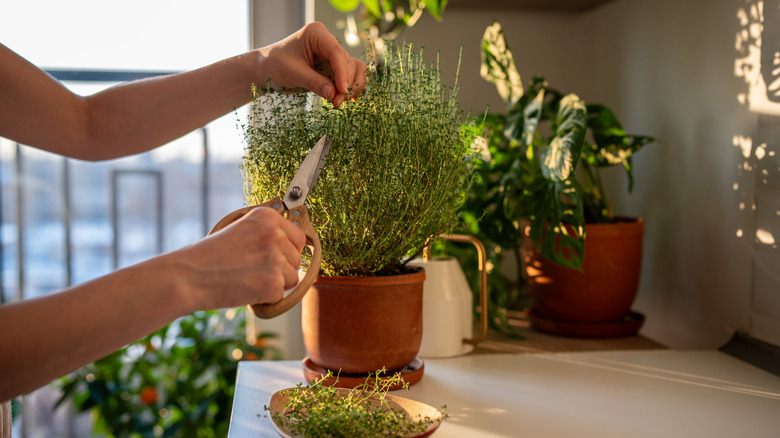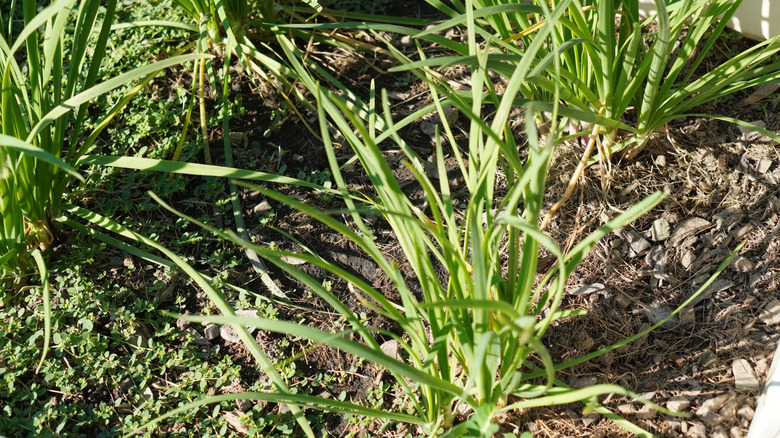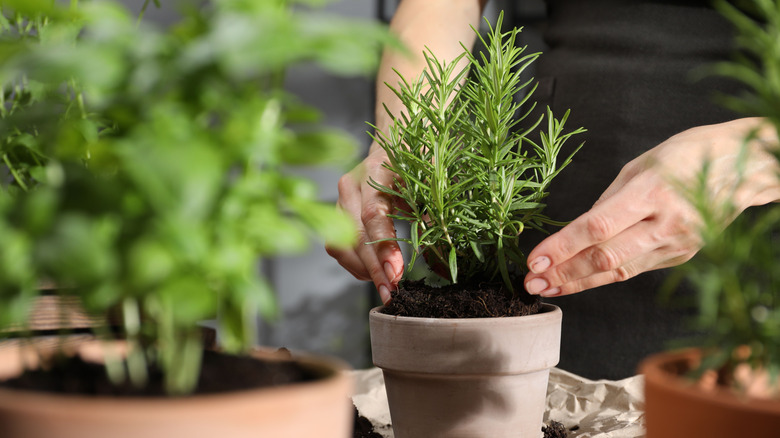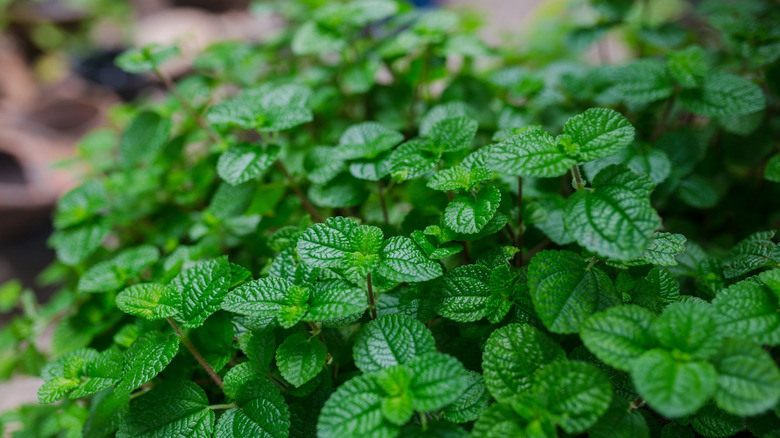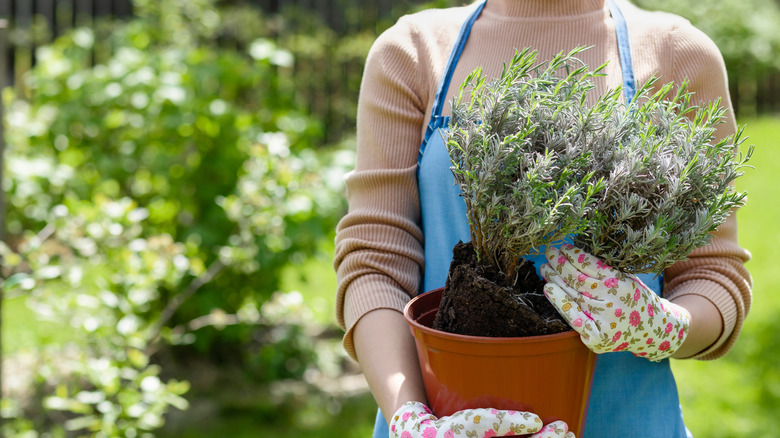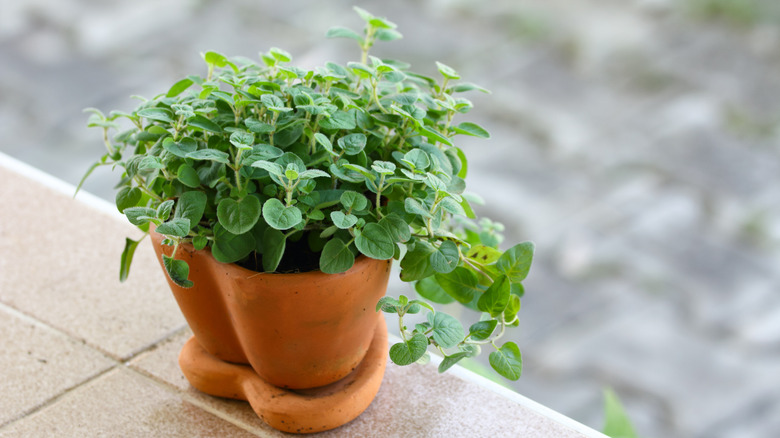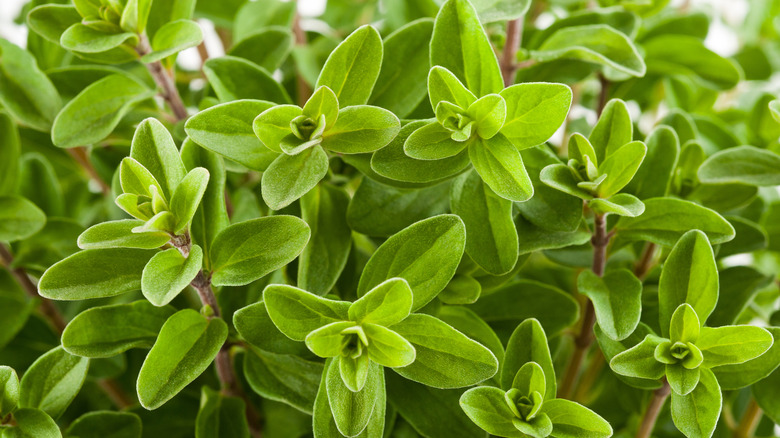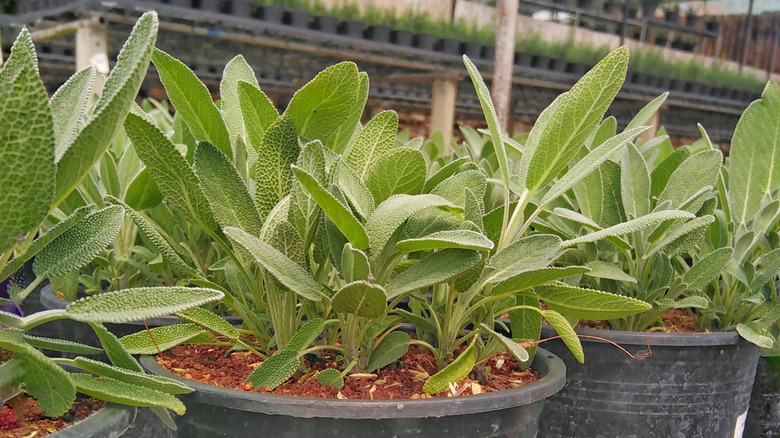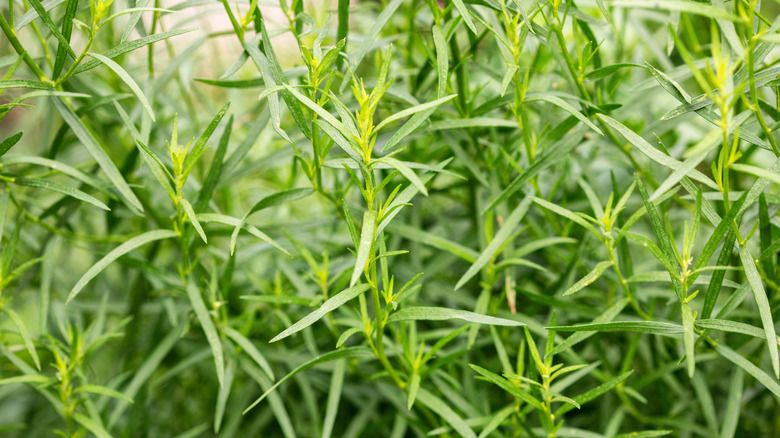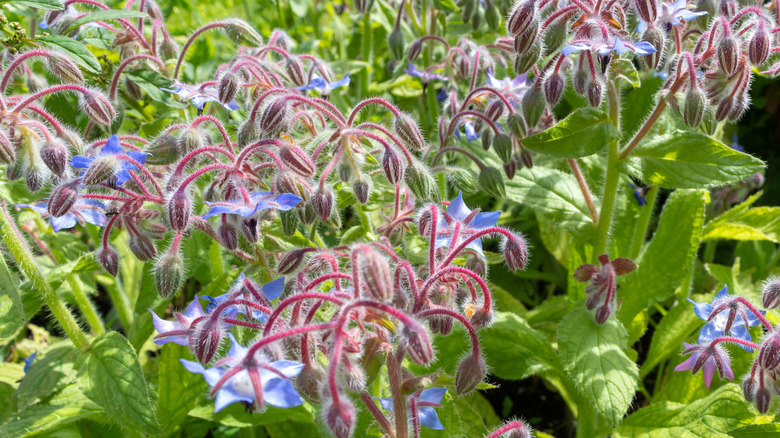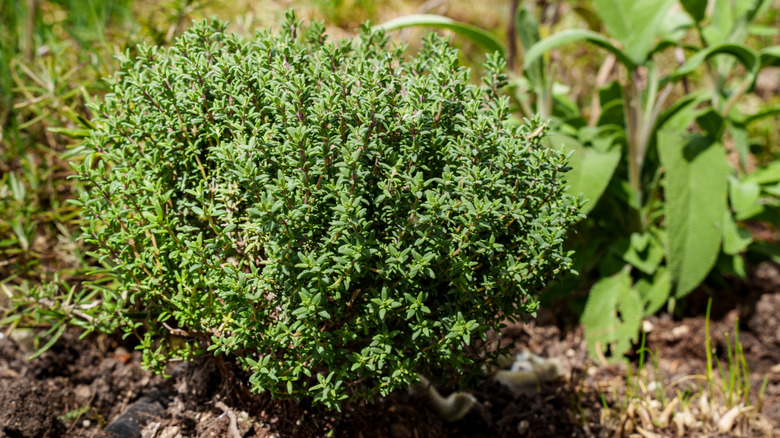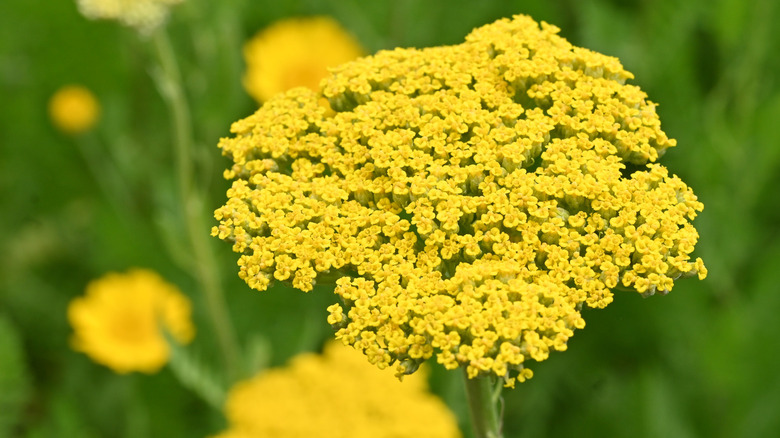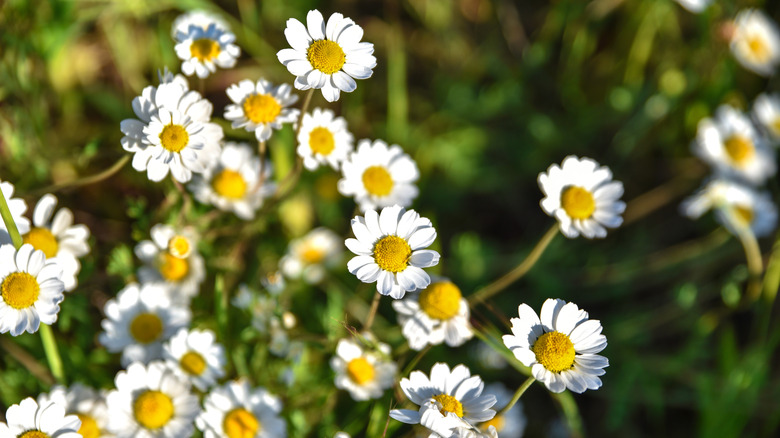12 Herbs That Are Easy For Even The Most Forgetful People To Grow
Let the hardcore gardeners nurture their finicky orchids! Forgetful or casual gardeners can keep plants alive, too. Tons of delicious culinary herbs can grow quite happily in your indoor or outdoor garden without a lot of hands-on effort from you. The key to a flourishing, low-maintenance herb garden is doing your research. Finding herbs that will naturally thrive in your environment gives you some leeway to neglect them. (So even if you forget to water them for 10 or 11 days, you hopefully won't kill them.)
Do you plan to grow herbs outdoors, either in the ground or in containers? Make sure you know what USDA growing zone you live in. It will help you identify the specific herb varieties that are best suited for your climate. Staff at your local plant nursery can also recommend specific varieties. If you plan to grow herbs in the ground, look for perennials that are hardy in your zone. Once they're established, they should come back every year, so you don't even have to remember to replant them again in spring.
For an indoor herb garden, assess the sun exposure and temperature of the room where your plants will live. Choosing plants that like dry soil and can all be on the same general watering schedule is ideal. (Self-watering houseplant systems are an option, but they have drawbacks.) You can water them all at the same time and not have to think about this task for another week or so.
Garlic chives grow vigorously
Garlic chives (Allium tuberosum) are so vigorous that they can become invasive. That's often a good sign for forgetful gardeners: A plant that grows and spreads quickly tends to be pretty self-sufficient. They don't require a lot of hands-on care. Garlic chives are also a tasty savory addition to your garden. They can give off a strong garlic smell, but this herb tastes much milder than actual cloves of garlic. Once you get a successful garlic chive plant going, add them to soups and stir-fries, and as a garnish for potato dishes!
Garlic chives are hardy perennial herbs. A well-established plant in your garden can go dormant during a cold and snowy winter, and sprout new garlic chives in the spring. (Consider a plant well-established once you start seeing new growth.) As with other hardy perennial herbs, garlic chives should be covered with mulch throughout the winter. This herb can also thrive in an indoor container garden, under the right conditions. Garlic chives don't need full sunlight, but do prefer at least 6 hours a day of indirect sunlight. Finally, an important caveat for pet owners. Like other alliums, garlic chives are toxic to dogs, cats, and horses.
Rosemary needs hardly any water to survive
Rosemary (Salvia rosmarinus) packs a punch in terms of flavor and aroma, but doesn't require a ton of attention in order to thrive. This herb doesn't like a lot of water. In fact, watering it too frequently can cause root rot. Rosemary only needs a drink once its soil is nice and dry. A well-established rosemary plant may actually be fine with only being watered once every two weeks. Planted outdoors, occasional rainfall could sustain rosemary with no extra help from you. Typically there's no need to fertilize this plant either.
Here's another reason rosemary is a good choice for forgetful gardeners: It doesn't germinate well. That means you shouldn't even try bother with all the daily watering and close monitoring that's required when you start new plants from seeds. Just buy rosemary that's already potted or replant some cuttings from an existing, well-established plant. Choose a spot to plant or place your potted rosemary where it will be get six to eight hours of sunlight every day. Rosemary is also a perennial and can survive a winter outdoors, if you live somewhere fairly temperate. Conditions colder than a light freeze could kill rosemary planted outdoors, though. Take rosemary indoors during the winter if you live in Zone 7 or colder.
Mint grows quickly and is hardy
Mint is many things: delicious, versatile, fragrant, and, frankly, a little rambunctious. It's hardy and grows quickly. Mint does need damp soil, so it may struggle if you forget to water it for a few weeks. But the tradeoff is that grows quickly, can do well in partial shade, and can be revived if you do accidentally neglect it for too long. (A wilted, dead-looking mint plant can be pruned all the way to the soil. Cover with fresh soil, water it well, and it may come back to life within a few weeks.)
Mint tends to be easy to grow indoors. Planted outside, it will die back in the winter, but can survive freezing temperatures and return in the spring. Forgetful gardeners should plant mint in containers, rather than in the garden. Remember, it's rambunctious. It you neglect mint too long in the garden, it can overtake everything. Planting it in containers ensures that it can't encroach on any of your other plants, just in case you do forget to look after it. There are many varieties with slightly different flavor profiles. Spearmint (Mentha spicata) and peppermint (Mentha × piperita) are two common types that are flavorful and hard to kill. Note that mint can also be toxic to dogs, cats, and horses when ingested in large amounts.
Lavender is super low-maintenance
Lavender can be a great herb for forgetful folks to grow. For one, it's hardy and doesn't require much maintenance. A well-established lavender plant doesn't need to be watered until its soil is totally dry, so you can ignore it for a week or more without doing any damage. It's also super fragrant, which is a perk for absentminded gardeners. Maybe catching a whiff of its scent as you pass through your yard or home will remind you to check on your lavender's progress. Harvesting your own lavender feels like an act of self-care.
Even an attentive caretaker can have a lavender bush fail if it's planted at the wrong time of year or isn't hardy enough for their climate. English lavender (Lavandula angustifolia) is one of the most common varieties and is hardy in Zones 5 through 10. Plant lavender in soil with good drainage, and in a place where it will receive full sunlight. Timing is important too, if you want to grow lavender outdoors. In colder climates, lavender should be planted in the spring after the frost has passed. It can be planted in early fall, but could fail if a cold snap strikes before the roots are established. In warmer climates, planting in early fall is ideal; a new plant gets time to get established without the threat of extreme summer heat. Lavender is another one that's toxic to dogs, cats, and horses.
Oregano is drought-tolerant and actually prefers slightly dry soil
Oregano (Origanum vulgare subsp. hirtum) is another relatively low-maintenance herb that's worth growing, especially if you love to cook savory, flavorful dishes. Fresh or dried oregano brings some spicy earthiness to tomato dishes, roasted proteins or veggies, sauces and vinaigrettes, and much more. It doesn't need a lot of love from you to keep growing. Oregano is native to the dry climate of the Mediterranean, so it's not automatically doomed if you totally space on watering it for a few weeks. It's another perennial, so you can technically forget about it all winter without killing it!
There are many varieties of oregano that grow pretty happily in most parts of the U.S. Italian oregano and Greek oregano have similar flavor. They both like full sun, but can handle some shade. Skip the seeds and get an oregano plant that's already started. This herb tends to grow better from cuttings than from seed. Plus, you won't have to remember to water new seedlings this way. But you do need to remember to check on an established plant every so often. When you see flowers beginning to bud, pinch them off and harvest the leaves. Letting an oregano plant flower will hurt the flavor of the leaves and can stop the plant from continuing to grow. Oregano is toxic to pets, so plant it cautiously.
A once-a-week watering is all marjoram needs
Think of marjoram and oregano as cousins who have a lot in common. You might want to grow just one or the other because they have similar flavors. That means they can often be used interchangeably in recipes. Or, if you really enjoy this flavor profile, grow both and enjoy the contrast between the bolder oregano and the milder, floral, slightly lemon-y marjoram. Marjoram is also native to the Mediterranean and doesn't like to be overwatered. Giving it a drink of water once a week should be sufficient to keep an established plant going.
Sweet marjoram (Origanum majorana) can do well in an indoor herb garden. The plant may only grow to be 12 tall, so it's fairly compact. Marjoram isn't quite as hardy as oregano and may not come back after a harsh winter outdoors. Remove flower buds from the plant whenever you notice them appear. This plant is also toxic to your furry friends.
Sage isn't needy and is also easy to start from seed
Sage has a lot of culinary uses and a soothing, earthy aroma. Some people burn dried sage for ceremonial purposes, but you can also burn a sage bundle outdoors as a mosquito repellant. Best of all for forgetful gardeners, it doesn't need a lot of attention. Edible common sage (salvia officianalis) doesn't like overly damp soil and is fairly resilient and hardy. It's okay if you only water sage when its soil dries out.
In addition to common sage, many varieties of this herb can be grown successfully indoors, provided plenty of full sun. As an outdoor perennial? Some varieties will only last one growing season in colder climates. Pineapple sage is one example. It smells and tastes like pineapple, and grows much faster and taller than common sage. But it's only hardy in Zones 8 through 11. In much of the U.S., the winters gets cold enough that pineapple sage is unlikely to come back in the spring. Common sage is also only hardy in Zones 8 through 11. All that really means is that you'll have to try to remember to replant them again in the spring.
French tarragon or Mexican tarragon are great options depending on your specific climate
Tarragon makes a great, low-maintenance addition to a culinary herb garden... assuming you like its controversial anise-like flavor. This herb is a staple in French cooking and has medicinal properties. But different varieties prefer different climates, so growing the right type is key. Either French or Mexican tarragon might thrive for you. (Avoid Russian tarragon, which has weaker flavor.)
French tarragon (Artemisia dracunculus var. sativa) grows well in warm climates and is hardy enough to survive cold winters planted outdoors. It doesn't like extreme heat, though. Tarragon should be started from propagated cuttings, rather than from seeds. French tarragon needs frequent watering when it's newly planted. Once the plant is established and you see new growth, you're fine to let the soil dry out. Watering once a week should be sufficient.
Mexican tarragon (Tagetes lucida) is a better alternative if you live somewhere steamy like Texas or Florida. While it has a similar flavor to French tarragon, this plant thrives in hot, humid climates. Mexican tarragon also has pretty flowers that attract bees and butterflies. It starts growing slowly, but once established, is drought tolerant and it's fine to let its soil dry out between waterings. Try to direct water just to the soil and not get the leaves wet. Tarragon is toxic to dogs, cats, and horses.
Borage isn't fussy and also will provide a pollinator haven
Borage (Borago officinalis) isn't an herb everyone's familiar with. But anyone with an interest in herb gardening needs to get to know it — especially if you're not looking to do a lot of hands-on gardening. At first glance, a flourishing borage plant looks more like ornamental flowers than edible herbs. In fact, it's both. The flowers and leaves are edible — and it's a vigorous pollinator, too. Borage is a favorite of honey bees. Gardeners love it too, because it isn't fussy to grow or care for. (Borage is also a great companion plant for cucumbers, among other plants.)
Dry soil and full sun are ideal conditions for borage. Plant it from seeds, either started indoors or by planting directly in the soil. Start a borage plant in spring after the danger of frost has passed. Once it's established, it should self-seed, so it will come back the next year without you having to remember to plant seeds again. The fact that borage self-seeds does mean you might find seedlings in places you don't want plants to grow. They can be easily pulled out of the ground, though. It's always a good idea to wear gloves when handling borage; the plant is covered in hairs that might irritate the skin. It's also toxic to pets.
Thyme can be easily grown both outdoors and indoors
Thyme is another member of the "dry soil" club. You can grow it in your garden or indoors and ignore it outside of your weekly watering routine. That said, as with so many types of herbs, choosing the right variety is key. And thyme has a ton of varieties — hundreds, in fact! For a basic herb garden, you can't go wrong with common thyme (Thymus vulgaris). It has a woodsy, herbal flavor. Or, plant French thyme. It's a variety of common thyme, requires similar growing conditions, and has a slightly sweeter, milder flavor. Lemon thyme (Thymus citriodorus) is another relatively low-maintenance option. Its lemony flavor makes it a tasty addition to both sweet and savory dishes. It smells pleasantly citrusy, too.
All three of these varieties of thyme like lots of direct sunlight and dry, well-drained soil. They're all hardy enough to thrive as outdoor perennials in Zones 5 through 9. Thyme can work well as part of an indoor year-round herb garden too, especially because these plants don't tend to take up much space. They typically max out at around 12 inches tall and 12 inches wide.
Yarrow does just fine with drought and poor soil
Yarrow (Achillea millefolium) is another low-maintenance herb that you might not be familiar with. Fun fact: the International Herb Association just named yarrow the Herb of the Year in 2024. This distinction is intended to help educate the public about a lesser-known herb and its uses. Yarrow can be dried to make tea, or its flowers can be used to give salads, soups, and sauces a peppery kick. It also has a long history of being used for medicinal purposes. According to legend, yarrow was used by Achilles to heal wounds during the Trojan War.
For a forgetful gardener, yarrow is an asset, because it does well in drought conditions and poor soil. A yarrow plant can grow to be as tall as 3 feet and likes full sunlight. When planted outdoors, occasional rainfall may be enough to keep it alive with no extra watering. In a container garden, you can ignore it until the soil is completely dry. One important caveat: To be safe, steer clear of ingesting yarrow if you're pregnant. According to the University of Texas at El Paso, there's a possibility that it could cause uterine contractions. Pets should also steer clear of the herb.
Chamomile tolerates shady sites
Life is stressful, especially if you're so busy that you rarely get around to watering your plants. Having your own supply of soothing chamomile tea on hand might help you slow down and unwind. Start by growing German chamomile (Matricaria chamomilla) in your herb garden. It can be used to make potpourri or dried bouquets, as well as being used for tea. (Simply steep either fresh or dried flowers in hot water to make tea from your plant — it can also be used in your garden) Once established, chamomile only needs to be watered when the soil is totally dry.
Chamomile can be planted in a spot that doesn't get a ton of direct sunlight. Unlike a lot of the other herbs on this list, chamomile may grow well in partial shade, though it also likes full sunshine. Chamomile also can't be propagated from cuttings like many other herbs. Either start it from seed or buy a potted plant that's already started. Chamomile is toxic to dogs, cats, and horses. And don't grow chamomile if you or anyone who spends time around your home suffers from ragweed allergies, as it can trigger an allergic reaction in these people.
